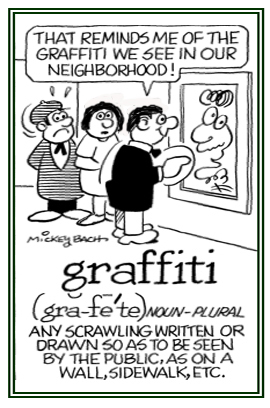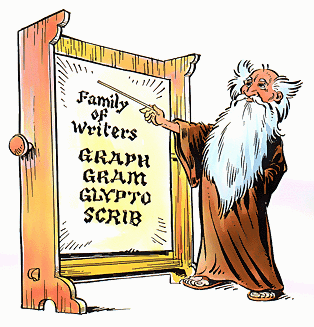grapho-, graph-, -graph, -graphy, -grapher, -graphia
(Greek: to scratch; to write, to record, to draw, to describe; that which is written or described)
As indicated at the bottom of this page, there is a significantly large number of graphic word-entry groups in this unit. Such an extensive listing is provided to show how important the grapho- element is to the English language.
glyphography
An electrotype process by which a copy of an engraved plate is obtained with a raised surface, suited for letter-press printing.
glyptograph
glyptographic
glyptography
1. The art of engraving upon gems.
2. The descriptive science of engraved gems.
2. The descriptive science of engraved gems.
gnathography
The recording of the action of the masticatory apparatus (chewing food in preparation for swallowing and digestion) while it is functioning.
1. A drawing or inscription made on a wall or other surface; usually, so as to be seen by other people.
2. Etymology: This is the plural of Italian graffito, “an inscription scratched on rocks or walls or on artifacts made of plaster, stone, or clay”.

© ALL rights are reserved.
Go to this Word A Day Revisited Index
2. Etymology: This is the plural of Italian graffito, “an inscription scratched on rocks or walls or on artifacts made of plaster, stone, or clay”.
Many writers agree that graffito came from Greek graphein, “to scratch”.

Go to this Word A Day Revisited Index
so you can see more of Mickey Bach's cartoons.
Here is a list of Graffiti Statements for you to enjoy which once appeared in U.S. newspapers.
- The more useless the antique the higher its value.
- It's difficult to soar like an eagle if you work with turkeys.
- It's cheaper to hear the patter of little feet than the stomping of $40 boots.
- A lot of overnight packages are delivered like there's no tomorrow.
- The credibility gap is the one between the nose and the chin.
- A genealogist traces your family tree as far back as your money goes.
- Two can live as cheaply as one, if they're both working.
- Stop pollution or the future will be a thing of the past.
- Bigamy: two rites making a wrong.
- The light bulb was Edison's bright idea.
- The worst thing about kitchen accidents is that you have to eat them.
- We need a pesticide for litterbugs.
- The only substitute for intelligence is silence.
- Gossip or news depends on who's telling and who's listening.
- Many people get unlimited mileage out of a limited vocabulary.
- Over eating makes you thick to your stomach.
- Talk softly, you never know when you may have to eat your words.
- Most 1st graders think V comes after T in the alphabet.
- History repeats itself 'cause no one listens the first time.
- Don't criticize your boss' judgment--look who he hired.
- For every person who can't read, there are two who won't.
- Walking is good for your health--but in some neighborhoods, running saves your life.
- A ventriloquist is a comedian who tells jokes without moving his lips.
- If you can keep your head when all those around you are losing theirs, you don't understand the situation.
- Observation, not old age, brings wisdom.
graph
1. A kind of symbolic diagram (used in chemistry, mathematics, etc.) in which a system of connexions is expressed by spots or circles, some pairs of which are colligated by one or more lines. Also, occasionally the system expressed by one of these diagrams.
2. In medicine, a line or tracing denoting varying values of commodities, temperatures, urinary output, etc.; more generally, any geometric or pictorial representation of measurements that might otherwise be expressed in tabular form.
3. An apparatus of the nature of the chromograph, hectograph, etc., for taking copies of writing by pressing it on a gelatinous surface.
4. In philology, a visual symbol representing a phoneme or a segment or feature of speech; especially, a letter, or one of its occurrent forms, or a combination of letters.
2. In medicine, a line or tracing denoting varying values of commodities, temperatures, urinary output, etc.; more generally, any geometric or pictorial representation of measurements that might otherwise be expressed in tabular form.
3. An apparatus of the nature of the chromograph, hectograph, etc., for taking copies of writing by pressing it on a gelatinous surface.
4. In philology, a visual symbol representing a phoneme or a segment or feature of speech; especially, a letter, or one of its occurrent forms, or a combination of letters.
graphanalysis
The reading of character or personality from a person’s handwriting.
graphanalyst
One who specializes in character reading or analysis of peoples’ handwriting.
1. The inability to recognize letters that are traced one at a time on the palm of the hand while the subject's eyes are closed: One of the neurological tests which Dr. James administered was for
graphanesthesia when he traced letters on Bill's hand to see if he could recognize the letters while his eyes were closed.
2. The inability to recognize figures or letters written by touching with a blunt instrument on the skin which may be caused by the spinal cord or as a result of a brain disease: After her accident and injury to her spinal cord, Matthew, the physiotherapist, worked with Barbara to overcome her graphanesthesia.
2. The inability to recognize figures or letters written by touching with a blunt instrument on the skin which may be caused by the spinal cord or as a result of a brain disease: After her accident and injury to her spinal cord, Matthew, the physiotherapist, worked with Barbara to overcome her graphanesthesia.
1. Any of a set of written symbols, letters, or combinations of letters that represent the same sound, e.g. “f” in fat, “ph” in photo, and “gh” in tough.
2. A written symbol that is used to represent speech.
2. A written symbol that is used to represent speech.
In linguistics, the study of systems of writing and their relationship to the systems of the languages they represent.
The sense by which figures or numbers are recognized when written on the skin with a dull-pointed object: Graphesthesia on the palm of one’s hand is easier to recognize than when any letters are written on one’s back because there are more nerve receptors in the hands than on the back.
A term, coined on analogy with phonetics, is the study of the physical properties of the symbols that constitute writing systems: The following image provides an example of graphetics.

A scribe is pointing to family units related to writing.

graphic (adjective), more graphic, most graphic
1. Pertaining to a drawing or painting: The fine graphic arts of drawing, painting, engraving, etching, etc.; also, the techniques of production and design involved in printing and publishing.
2. Relating to the use of diagrams, linear figures, or symbolic curves.
3. Characteristic of designs and decorations that involve the production of pictures, diagrams, etc., in association with text: An example of the graphic arts or designs also includes a diagram, a pattern, a picture, etc., produced by means of a computer.
4. Descriptive of a number of vivid details; especially exciting or unpleasant ones.
5. Representing something such as a sound by means of letters or other written symbols: “Moo”, “woof”, and “meow” are graphic representations of the sounds made by cows, dogs, and cats respectively.

© ALL rights are reserved.
Go to this Word A Day Revisited Index
2. Relating to the use of diagrams, linear figures, or symbolic curves.
3. Characteristic of designs and decorations that involve the production of pictures, diagrams, etc., in association with text: An example of the graphic arts or designs also includes a diagram, a pattern, a picture, etc., produced by means of a computer.
4. Descriptive of a number of vivid details; especially exciting or unpleasant ones.
5. Representing something such as a sound by means of letters or other written symbols: “Moo”, “woof”, and “meow” are graphic representations of the sounds made by cows, dogs, and cats respectively.

Go to this Word A Day Revisited Index
so you can see more of Mickey Bach's cartoons.
Related "writing" word units:
glypto-;
gram-;
scrib-, script-.


